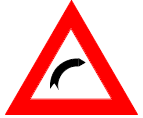26 DMV Questions of Safety Margins
Note:
If you wish to check whether you have master these questions, you may
click on the button above to practice with questions only from this DMV topic.
If you do not have an account yet,
Sign Up one now, it is FREE!
1. You have driven your car through a flood. What is the first thing you should do?
A. Stop and check the tyres
B. Stop and dry the brakes
C. Switch on your windscreen wipers
D. Test your brakes
2. If you are on good, dry road surface and your vehicle has good brakes and tyres, what is the overall stopping distance at 30mph (48 km/h)?
A. 23 metres (75 feet)
B. 36 metres (118 feet)
C. 53 metres (174 feet)
D. 96 metres (315 feet)
3. Anti-lock brakes reduce the chances of a skid occurring particularly when:
A. Driving down steep hills
B. Breaking during normal driving
C. Breaking in an emergency
D. Driving on good road surfaces
4. You are on a fast, open road and driving in good conditions. For safety, the distance between you and the vehicle in front should be:
 A. A two-second time gapB. One car lengthC. 2 metre (6 feet 6 inches)D. Two car lengths
A. A two-second time gapB. One car lengthC. 2 metre (6 feet 6 inches)D. Two car lengths
5. The 'two-second rule' allows you to:
A. Keep a safe distance from the car in front
B. Keep the correct distance from the kerb
C. Check your blind spot
D. Check your mirrors
6. What is the most common reason a car skids?
A. Worn tyres
B. Driver error
C. Other vehicles
D. Pedestrians
7. You are driving in heavy rain. Your steering suddenly becomes very light. You should
A. Steer towards the side of the road
B. Apply gentle acceleration
C. Brake firmly to reduce speed
D. Ease off the accelerator
8. Braking hard at a high speed on a sharp bend can make your vehicle
A. More stable
B. Unstable
C. Stall
D. Corner safely
9. If your car is fitted with anti-lock brakes, and you need to stop in an emergency. You should:
A. Brake normally and avoid turning the steering wheel
B. Press the brake pedal rapidly and firmly until you have stopped
C. Keep pushing and releasing the foot brake quickly to prevent skidding
D. Apply the handbrake to reduce the stopping distance
10. You are turning left on a slippery road. The back of your vehicle slides to the right. You should:
A. Brake firmly and not turn the steering wheel
B. Steer carefully to the left
C. Steer carefully to the right
D. Brake firmly and steer to the left
11. You are approaching a right-hand bend. You should:
 A. Keep well to the left as it makes the bend fasterB. Keep well to the left for a better view around the bendC. Keep well to the right to avoid anything in the gutterD. Keep well to the right to make the bend less sharp
A. Keep well to the left as it makes the bend fasterB. Keep well to the left for a better view around the bendC. Keep well to the right to avoid anything in the gutterD. Keep well to the right to make the bend less sharp
12. 'Only a fool breaks the Two-Second Rule' refers to:
A. The time recommended when using the choke
B. The separation distance when riding in good conditions
C. Restarting a stalled engine in busy traffic
D. The time you should keep your foot down at a junction
13. When should you use front and rear fog lights?
A. During any time of the day or night to make sure that other road users see me.
B. When going through tunnels.
C. When the road is unlit by street lamps or they are not working.
D. When it is raining and just in case the roads are slippery.
E. When visibility is considerably reduced because of fog.
14. Your overall stopping distance will be longer when driving:
A. In the rain
B. In fog
C. At night
D. In strong winds
15. Vehicles fitted with an anti-lock brake system
A. Are impossible to skid
B. Can be steered while you are braking
C. Accelerate much faster
D. Are not fitted with a handbrake
16. You are driving in a built-up residential area. You should:
 A. Move across to the lefthand side of the roadB. Wait for any pedestrians to crossC. Slow your vehicle right downD. Stop and check both pavements
A. Move across to the lefthand side of the roadB. Wait for any pedestrians to crossC. Slow your vehicle right downD. Stop and check both pavements
17. When braking hard in a straight line, most of the weight of the vehicle will shift onto the
A. Front wheels
B. Rear wheels
C. Left wheels
D. Right wheels
18. You are about to go down a steep hill. To control the speed of your car you should:
A. Select a high gear and use the brakes carefully
B. Select a high gear and use the brakes firmly
C. Select a low gear and use the brakes carefully
D. Select a low gear and avoid using the brakes
19. How can you use the engine of your vehicle as a brake?
A. By changing to a lower gear
B. By selecting reverse gear
C. By changing to a higher gear
D. By selecting neutral gear
20. You are on a long, downhill slope. What should you do to help control the speed of your car?
A. Select neutral
B. Select a lower gear
C. Grip the handbrake firmly
D. Apply the parking brake gently
21. If you are at a junction with limited visibility, you should:
A. Creep forward, looking to the right
B. Creep forward, looking to the left
C. Creep forward, looking both ways
D. Be ready to move off quickly
22. When approaching a right-hand bend you should keep well to the left. Why this?
 A. To improve your view of the roadB. To overcome the effect of the road’s slopeC. To let faster traffic from behind overtakeD. To be positioned safely if the vehicle skids
A. To improve your view of the roadB. To overcome the effect of the road’s slopeC. To let faster traffic from behind overtakeD. To be positioned safely if the vehicle skids
23. Your indicators may be difficult to see in bright sunlight. What should you do?
A. Give an arm signal as well as using your indicator
B. Touch the brake several times to show the stop lamp(s)
C. Turn as quickly as you can
24. Your vehicle does not have anti-lock brakes. If you are braking on a wet road and your vehicle begins to skid. What is the FIRST thing you should do?
A. Quickly pull up the handbrake
B. Release the footbrake fully
C. Push harder on the brake pedal
D. Gently use the accelerator
25. The main cause of skidding is:
A. The weather
B. The driver
C. The vehicle
D. The road
26. Coasting the car:
A. Improves the driver’s control
B. Makes steering easier
C. Reduces the driver’s control
D. Uses more fuel
If you wish to check whether you have master these questions, you may
click on the above button to practice with questions only from this DMV topic.
If you do not have an account yet,
Sign Up one now, it is FREE!



